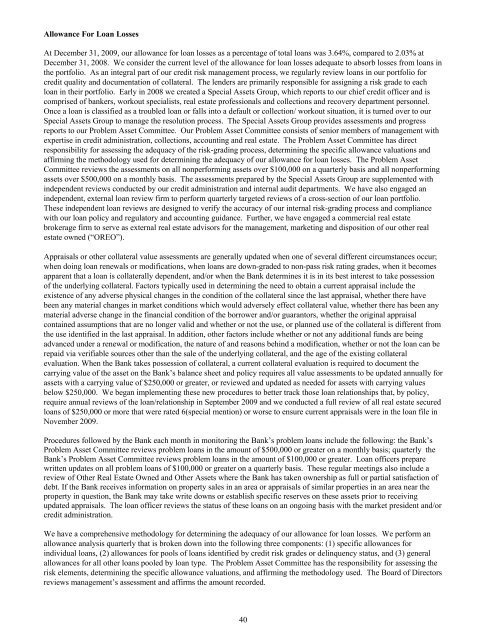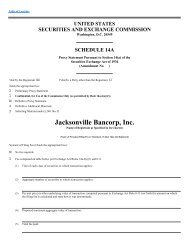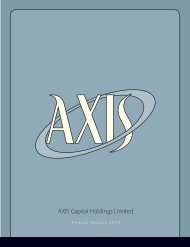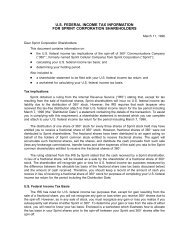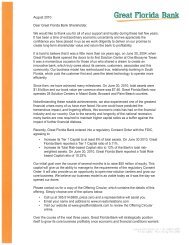pab bankshares, inc. - SNL Financial
pab bankshares, inc. - SNL Financial
pab bankshares, inc. - SNL Financial
You also want an ePaper? Increase the reach of your titles
YUMPU automatically turns print PDFs into web optimized ePapers that Google loves.
Allowance For Loan Losses<br />
At December 31, 2009, our allowance for loan losses as a percentage of total loans was 3.64%, compared to 2.03% at<br />
December 31, 2008. We consider the current level of the allowance for loan losses adequate to absorb losses from loans in<br />
the portfolio. As an integral part of our credit risk management process, we regularly review loans in our portfolio for<br />
credit quality and documentation of collateral. The lenders are primarily responsible for assigning a risk grade to each<br />
loan in their portfolio. Early in 2008 we created a Special Assets Group, which reports to our chief credit officer and is<br />
comprised of bankers, workout specialists, real estate professionals and collections and recovery department personnel.<br />
Once a loan is classified as a troubled loan or falls into a default or collection/ workout situation, it is turned over to our<br />
Special Assets Group to manage the resolution process. The Special Assets Group provides assessments and progress<br />
reports to our Problem Asset Committee. Our Problem Asset Committee consists of senior members of management with<br />
expertise in credit administration, collections, accounting and real estate. The Problem Asset Committee has direct<br />
responsibility for assessing the adequacy of the risk-grading process, determining the specific allowance valuations and<br />
affirming the methodology used for determining the adequacy of our allowance for loan losses. The Problem Asset<br />
Committee reviews the assessments on all nonperforming assets over $100,000 on a quarterly basis and all nonperforming<br />
assets over $500,000 on a monthly basis. The assessments prepared by the Special Assets Group are supplemented with<br />
independent reviews conducted by our credit administration and internal audit departments. We have also engaged an<br />
independent, external loan review firm to perform quarterly targeted reviews of a cross-section of our loan portfolio.<br />
These independent loan reviews are designed to verify the accuracy of our internal risk-grading process and compliance<br />
with our loan policy and regulatory and accounting guidance. Further, we have engaged a commercial real estate<br />
brokerage firm to serve as external real estate advisors for the management, marketing and disposition of our other real<br />
estate owned (“OREO”).<br />
Appraisals or other collateral value assessments are generally updated when one of several different circumstances occur;<br />
when doing loan renewals or modifications, when loans are down-graded to non-pass risk rating grades, when it becomes<br />
apparent that a loan is collaterally dependent, and/or when the Bank determines it is in its best interest to take possession<br />
of the underlying collateral. Factors typically used in determining the need to obtain a current appraisal <strong>inc</strong>lude the<br />
existence of any adverse physical changes in the condition of the collateral s<strong>inc</strong>e the last appraisal, whether there have<br />
been any material changes in market conditions which would adversely effect collateral value, whether there has been any<br />
material adverse change in the financial condition of the borrower and/or guarantors, whether the original appraisal<br />
contained assumptions that are no longer valid and whether or not the use, or planned use of the collateral is different from<br />
the use identified in the last appraisal. In addition, other factors <strong>inc</strong>lude whether or not any additional funds are being<br />
advanced under a renewal or modification, the nature of and reasons behind a modification, whether or not the loan can be<br />
repaid via verifiable sources other than the sale of the underlying collateral, and the age of the existing collateral<br />
evaluation. When the Bank takes possession of collateral, a current collateral evaluation is required to document the<br />
carrying value of the asset on the Bank’s balance sheet and policy requires all value assessments to be updated annually for<br />
assets with a carrying value of $250,000 or greater, or reviewed and updated as needed for assets with carrying values<br />
below $250,000. We began implementing these new procedures to better track those loan relationships that, by policy,<br />
require annual reviews of the loan/relationship in September 2009 and we conducted a full review of all real estate secured<br />
loans of $250,000 or more that were rated 6(special mention) or worse to ensure current appraisals were in the loan file in<br />
November 2009.<br />
Procedures followed by the Bank each month in monitoring the Bank’s problem loans <strong>inc</strong>lude the following: the Bank’s<br />
Problem Asset Committee reviews problem loans in the amount of $500,000 or greater on a monthly basis; quarterly the<br />
Bank’s Problem Asset Committee reviews problem loans in the amount of $100,000 or greater. Loan officers prepare<br />
written updates on all problem loans of $100,000 or greater on a quarterly basis. These regular meetings also <strong>inc</strong>lude a<br />
review of Other Real Estate Owned and Other Assets where the Bank has taken ownership as full or partial satisfaction of<br />
debt. If the Bank receives information on property sales in an area or appraisals of similar properties in an area near the<br />
property in question, the Bank may take write downs or establish specific reserves on these assets prior to receiving<br />
updated appraisals. The loan officer reviews the status of these loans on an ongoing basis with the market president and/or<br />
credit administration.<br />
We have a comprehensive methodology for determining the adequacy of our allowance for loan losses. We perform an<br />
allowance analysis quarterly that is broken down into the following three components: (1) specific allowances for<br />
individual loans, (2) allowances for pools of loans identified by credit risk grades or delinquency status, and (3) general<br />
allowances for all other loans pooled by loan type. The Problem Asset Committee has the responsibility for assessing the<br />
risk elements, determining the specific allowance valuations, and affirming the methodology used. The Board of Directors<br />
reviews management’s assessment and affirms the amount recorded.<br />
40


